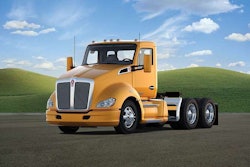
Fleets in search of better fuel economy have found some solutions in looking at the tires on the trucks.
An increasingly popular option is upgrading dual tires to wide-base, but in making any tire or wheel related changes, it’s important to understand that just because the tire or wheel will fit, it may not be the best option.
“Options for tires are limited by load-carrying capacity and axle/vehicle configurations,” says Steve Wilton, vice president, fleet solutions, Wingfoot Commercial Tire Systems LLC. “Conversion of a unit from dual tires to wide-base tires also can sometimes have ramifications on wheel bearings and other components.”
“You always have to have the right wheel under the tire,” adds Doug Reis, Senior Project Engineer for Accuride. “When spec’ing wheel and tires you have the studs. If you switch – say from steel to aluminum – you may not have enough stud sticking out to properly mount the wheel because an aluminum wheel is much thicker that a steel wheel.”
In the aftermarket, before getting a list of options when you’re ready to make the change, it is important to understand those options may be limited by what was there in the first place.
“You really have to understand what was on the vehicle,” Brando Uzarek, Accuride Field Engineer, says. “There’s a lot of thought that needs to go into that process. Because the way the bearings and the axles are loaded, the clearance on the vehicle. You need a lot of data to understand that.”
Chris Putz, Maxion Principal Engineer also says it’s best not to put the cart before the horse when spec’ing wheels, because the wheel type will largely be dictated by the application.
“Before we get to the wheel, we would need to know the vehicle and we need to know the tire,” he says. “I need understand what the intended use and operations for that wheel are; meaning is it a single or dual wheel, what’s the type of vehicle, how fast will they be driving and what is the maximum load they would be carrying.”
From there Putz says the customer would get into the tire – which tire would be required for the usage, include size and construction.
“Safety is the first priority,” he adds, “and that means complying FMVSS (Federal Motor Vehicle Safety Standards) requirement for the proper load and fitment of the tire width and wheel.”
Reis say changes are also determined by which axle you’re are we working on due to the different offsets that correspond with different axel applications.
“On the front axels, when they convert from a single, which would be 8 ¼ wide, to something that is 12 ¼ wide to 13 inches wide, we really try to line up the inner walls of the tire – where the existing inner wall of the tire was – and we base it upon that, because if we go too much further in, we’re going to hit the suspension, the tie rods and it’s just a mess,” Uzarek adds. “If we go too far out, we’re going to create other issues, so we try to keep the inner wall in the same position.”
The rear of the truck, Reis says, comes down to which axle manufacturer the driver is using.
“Each axle manufacturer has their preferences on which outsets wheel they can use if they’re using 14 inch wheels,” he says. “There is a synergy between the way the wheels load the axle. There is synergy there for the bearings to live because you’ll create these bending moments the axels weren’t ever designed to carry. You’ll shorten the axle life basically if you don’t have the correct offsets and widths.”













